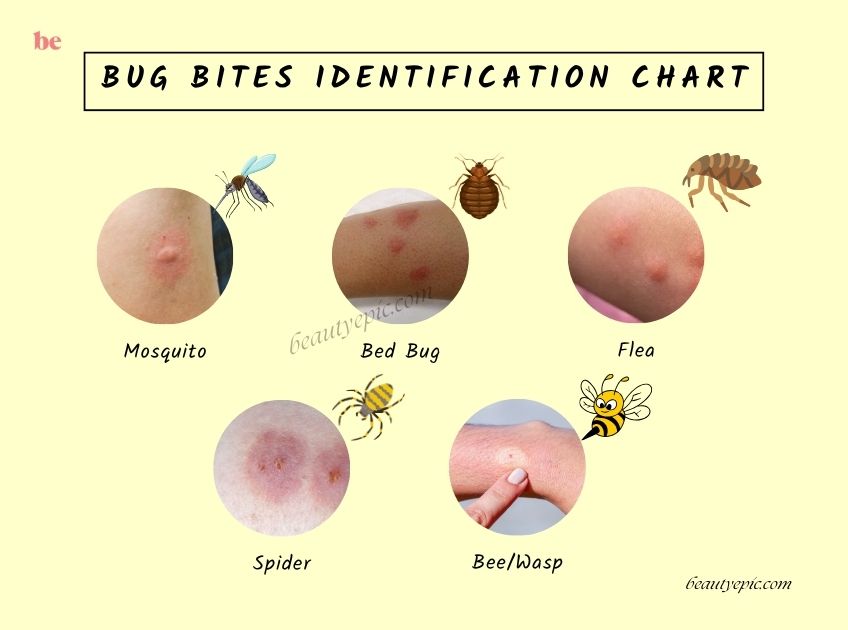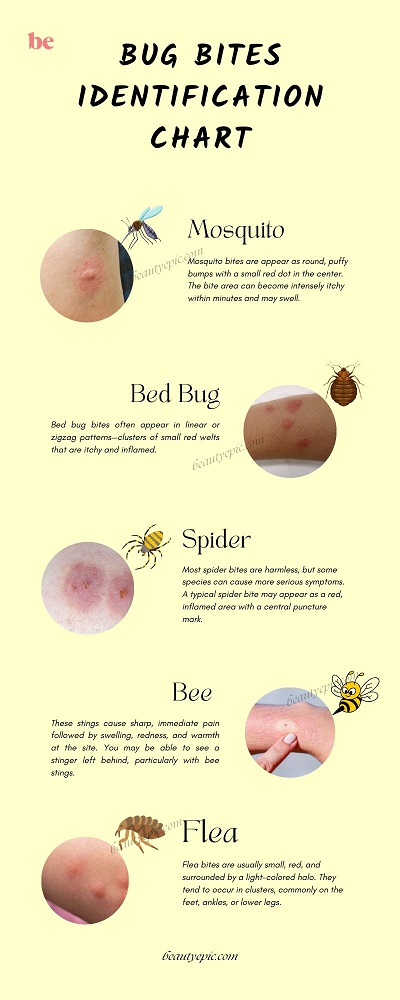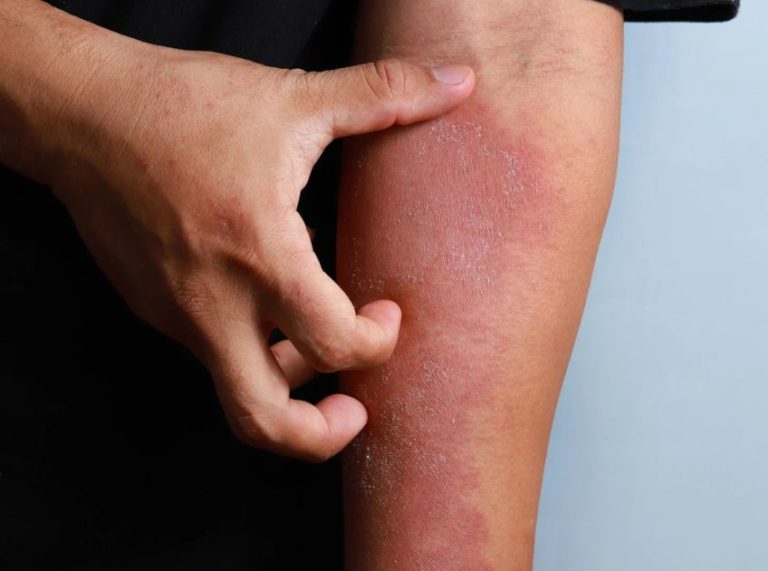
Important: This article is for informational purposes only. Please read our full disclaimer for more details.
You wake up with a red, itchy bump and wonder—was it a mosquito, bed bug, spider, or something else? Bug bites can look surprisingly similar, but identifying them correctly can help you treat symptoms effectively and avoid complications. This post features a visual and descriptive bug bites identification chart, backed by scientific understanding, to help you recognize and respond to common insect bites with confidence.
Spot the Bite: A Chart of Common Bug Bites and Their Features
Below is a quick-reference chart to help you distinguish between various types of bug bites based on appearance, symptoms, and common bite locations.
| Bug Type | Bite Appearance | Symptoms | Common Locations |
|---|---|---|---|
| Mosquito | Raised, puffy bump with a red dot | Itching, swelling, mild discomfort | Exposed skin: arms, legs, neck |
| Bed Bug | Small red welts in clusters or rows | Itching, inflammation, and may blister | Arms, back, legs, neck |
| Flea | Tiny red spots, often with a halo | Intense itching, grouped bites | Ankles, feet, lower legs |
| Spider | Red, swollen area, sometimes with puncture | Pain, burning, swelling, rare necrosis | Arms, legs, and underclothing |
| Tick | Firm, red bump with visible tick attached | Painless initially; may spread infection | Scalp, behind ears, groin, armpits |
| Ant (esp. fire) | Red bumps may develop pus-filled blisters | Burning, itching, stinging | Feet, ankles, hands |
| Bee/Wasp | Swollen, red welt, sometimes with stinger | Immediate pain, swelling, itching | Hands, arms, face, anywhere exposed |
Common Bug Bites and How to Identify Them
Mosquito Bites
Mosquito bites are among the most common and easily recognizable. They typically appear as round, puffy bumps with a small red dot in the center. The bite area can become intensely itchy within minutes and may swell. These bites often show up on exposed areas like arms, legs, neck, and face—especially during warmer months or at dusk.
Bed Bug Bites
Bed bug bites often appear in linear or zigzag patterns—clusters of small red welts that are itchy and inflamed. The bites are usually found on areas exposed while sleeping, such as arms, back, neck, or legs. Reactions can vary, but they tend to cause delayed itching that worsens over time.
Flea Bites
Flea bites are usually small, red, and surrounded by a light-colored halo. They tend to occur in clusters, commonly on the feet, ankles, or lower legs. These bites are extremely itchy and may lead to scabbing if scratched excessively. Flea bites are especially common in homes with pets.
Spider Bites
Most spider bites are harmless, but some species can cause more serious symptoms. A typical spider bite may appear as a red, inflamed area with a central puncture mark. The area might feel tender or painful and can occasionally develop into a blister or ulcer. Bites from spiders like the brown recluse or black widow may cause muscle cramps, fever, or tissue damage—so it’s important to monitor symptoms closely.
Tick Bites
Tick bites often go unnoticed at first because they are painless. You may find a tick attached to the skin, especially in hidden areas like the scalp, groin, or armpits. Once detached, the bite may leave a firm, red bump. A hallmark sign of Lyme disease (from black-legged ticks) is a bull’s-eye rash—a red ring with a clear center. If you notice this, seek medical attention immediately.
Ant Bites (Especially Fire Ants)
Fire ant bites cause immediate burning and itching, followed by red bumps that can turn into white pustules within a day. These bites are very painful and usually appear on the feet, ankles, or hands. People sensitive to ant venom may experience swelling or more severe allergic reactions.
Bee and Wasp Stings
These stings cause sharp, immediate pain followed by swelling, redness, and warmth at the site. You may be able to see a stinger left behind, particularly with bee stings. Most people experience localized reactions, but those allergic to venom can have systemic symptoms such as swelling of the throat or difficulty breathing, which requires emergency care.
What Science Says About Insect Bites and Their Reactions
Our body’s response to insect bites varies based on immune sensitivity, type of insect, and venom or saliva injected during the bite.
- Mosquitoes inject saliva that contains anticoagulants and proteins, triggering a mild allergic reaction, which explains the itchy swelling. (1)(2)
- Bed bug saliva contains anesthetics and anticoagulants, so bites are often painless initially but cause delayed itching and welts. (3)
- Tick bites are medically significant because they can transmit diseases like Lyme disease and Rocky Mountain spotted fever. According to NIH, early removal of ticks is key to reducing transmission (4).
- Spider bites, while mostly harmless, can rarely involve venom that causes tissue damage, such as from brown recluse or black widow species.
Scientific understanding helps in not just identifying, but also prioritizing medical attention when needed—especially in cases involving systemic symptoms like fever, fatigue, or rash.
Frequently Asked Questions (FAQ’S)
1. How can I tell the difference between a spider bite and a regular bug bite?
A. Spider bites are often more painful and localized. You may notice two puncture marks and swelling that can turn into a blister or ulcer. If symptoms include muscle pain or severe redness, seek medical attention.
2. What signs indicate a bite might be infected or need medical help?
A. Watch for signs like increasing redness, pus, fever, or red streaks spreading from the bite. These suggest infection. Seek help if the bite is from a tick, or you develop symptoms like joint pain or fatigue.
3. Can bug bites cause allergic reactions?
A. Yes. While most are mild, some people may develop hives, swelling beyond the bite site, or even anaphylaxis (especially from bee or wasp stings). Always carry an epinephrine auto-injector if you have a known severe allergy.
Bug bites are part of everyday life, but they don’t have to be a mystery. Using an identification chart, paying attention to symptoms, and understanding the science behind each reaction can help you treat them swiftly and safely. From mosquitoes to ticks and everything in between, a little knowledge can go a long way in preventing discomfort—or serious complications.
















